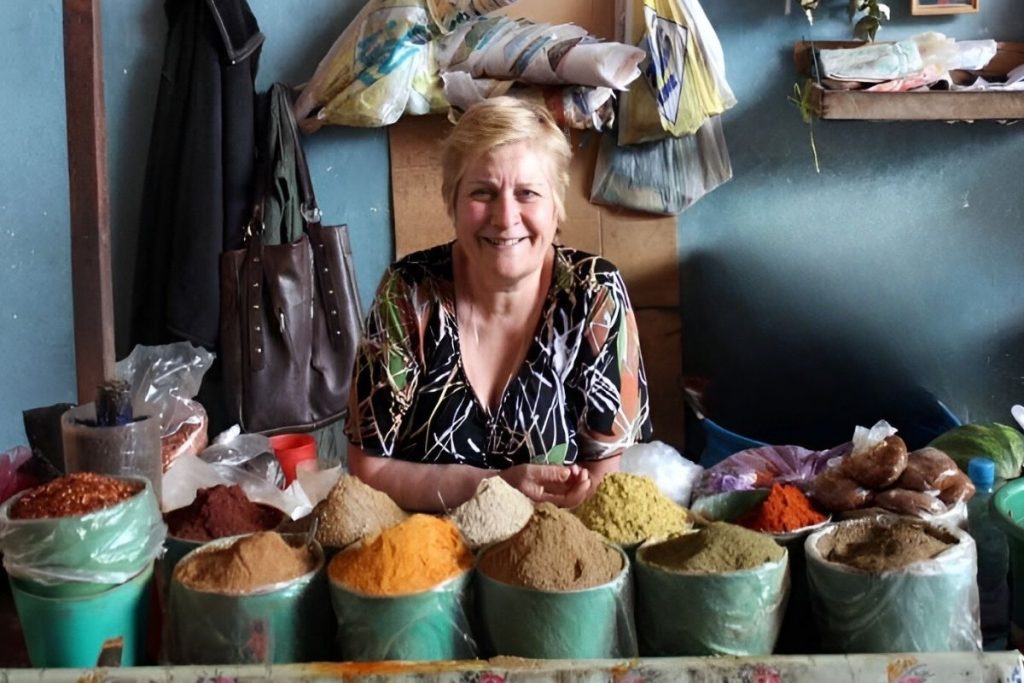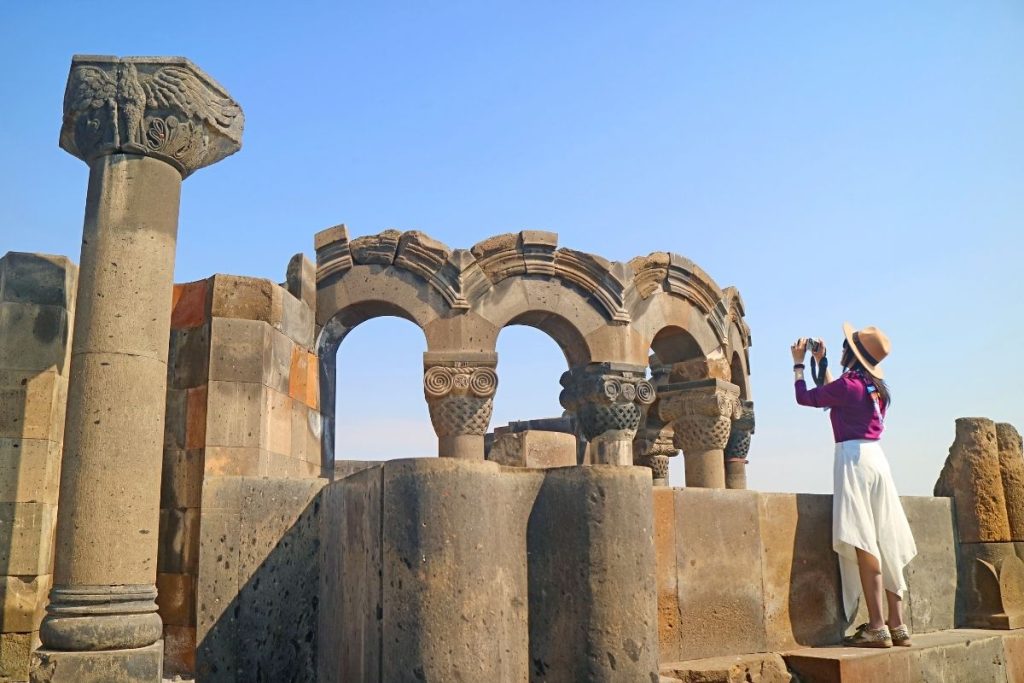Photo credit: Jake Smith
5 Reasons to Travel to Turkey (Türkiye) & the South Caucasus
How You Can Travel to Georgia, Armenia, and Azerbaijan

What makes the South Caucasus and Türkiye so special? It’s everything, all at once – the towering mountains, the rich history, the buzzing markets, the warm people.
Picture this: the snow-capped Caucasus Mountains in Georgia, towering so high they seem to meet the sky. Ancient Armenian monasteries, carved into rocky cliffs, each holding stories from centuries past. Then, the Grand Bazaar in Türkiye – bursts of color, the scent of spices in the air, the rhythmic calls of vendors drawing you in.
Every place feels fresh, new, and unlike anywhere else. It’s chaotic but in the best way.
This region is a rush of sights, sounds, and emotions. In short, traveling here leaves you with memories that last a lifetime.
Below, we’ve compiled the top five reasons to explore the South Caucasus and Türkiye. Take a look:
1. Musical Traditions

First on our list is musical traditions. The South Caucasus is full of music, and it beautifully reflects the culture of Azerbaijan, Georgia, and Armenia.
For example, in Azerbaijan, mugham blends poetry, melody, and instrumental improvisation. It creates an emotional and unique sound that represents the country’s identity.
Meanwhile, Georgia is famous for polyphonic singing, a complex style where voices blend in harmonies. This tradition, recognized by UNESCO, is connected to village life and spirituality. In fact, in 1977, a Georgian polyphonic song was sent into space on the Voyager spacecraft to represent Earth’s culture.
Similarly, in Armenia, a cappella chants fill ancient monasteries and it’s their haunting beauty that takes listeners on a journey through time.
2. Epic Landscapes
Next up is landscapes. Here’s what you can expect:
In Georgia, the Greater Caucasus mountains are filled with wonders. You’ll find wide meadows, clear glacial lakes, and deep valleys, dating back over 4,000 years.
Meanwhile, Armenia holds many hidden delights. For example, Lake Sevan is one of the highest freshwater lakes in the world. Additionally, Dilijan National Park is so lush and peaceful that people often call it the “Switzerland of Armenia.”
Azerbaijan’s nature, on the other hand, is full of contrasts. The Caspian Sea coast enjoys a warm, subtropical feel, while Gobustan National Park appears like the surface of the moon with ancient rock carvings and bubbling mud volcanoes.
3. Culinary Journeys

And here’s reason #3 – a favorite for many: the cuisine.
In Georgia, khachapuri is the standout of local cuisine. It is a cheesy bread that feels like a warm hug. Not only is it simple and rich, but it’s also loved by everyone.
In Azerbaijan, plov is the king of dishes. It’s rice cooked with saffron, meat, and fruits, so every bite tastes like history.
Meanwhile, in Armenia, gata is a sweet treat that pairs perfectly with tea. Because it’s been around for centuries, it tastes like home.
What makes these dishes even more special, however, are the people. Locals invite you to their tables with big smiles, and they are always ready to share food, stories, and their hearts.
4. Warm Hospitality

Perhaps feast-worthy cuisine is what feeds the love for good company – after all, the best meals are meant to be shared, right? Hospitality in the South Caucasus and Türkiye is a way of life. For instance, in Azerbaijan, every visit begins with tea and sweets, a simple yet meaningful gesture of warmth and respect. Similarly, in Georgia, meals turn into joyful celebrations. Tables overflow with bread, cheese, meats, and wine so that every toast strengthens bonds. In addition, in Armenia, communal feasts, especially during religious holidays, fill the air with heartfelt conversations, and a sense of togetherness. Across the region, visitors aren’t treated as tourists – instead, they’re welcome as family. Because of this, every meal feels personal, every interaction feels genuine, and ultimately, every moment leaves an unforgettable mark.
5. Ancient Heritage

Last but not least, we have history – because ancient civilizations left their marks everywhere in the South Caucasus and Türkiye. In Georgia, the land of Colchis brings myths to life. This is where Jason and the Argonauts searched for the Golden Fleece.
Armenia stands proud as one of the oldest Christian nations. Its monasteries, like the UNESCO-listed Geghard, symbolize deep spirituality and cultural resilience. In Azerbaijan, the Maiden Tower rises as a mysterious icon in Baku, while the Fire Temple of Ateshgah reflects ancient Zoroastrian beliefs.
And then there’s Türkiye – where history hits different.
Take Ephesus, once a booming Roman city. Its streets? Still there. Its stories? Still alive. Then there’s Cappadocia, where people turned rock into refuge.
And at the heart of it all? Hagia Sophia. A church. A mosque. A symbol. 1,500 years of empires rising and falling under its dome.
But Türkiye goes deeper. Göbekli Tepe is 11,000 years old – older than the pyramids, older than written history itself. Who built it? Why? No one knows.
Cultural Etiquette Quiz: South Caucasus & Türkiye
Think you have what it takes to nail the South Caucasus & Türkiye Cultural Etiquette quiz? Prove it!
1. In Georgia, why is it considered disrespectful to leave a meal unfinished when visiting someone’s home?
- A) It implies you didn’t enjoy the food.
- B) It signifies that you’re still hungry.
- C) It shows you’re eager to leave.
- D) It’s seen as wasteful.
Answer: A) It implies you didn’t enjoy the food
Explanation: In Georgia, finishing your plate is a sign of respect, but leaving food behind can indicate that you didn’t enjoy the meal. It is a practice rooted in hospitality—leaving food unfinished shows that the host’s offerings were not enough to satisfy you.
2. What does the tradition of ‘toasting’ in Georgia symbolize, especially during celebrations
- A) Good health and happiness
- B) Respect for the elderly
- C) Friendship and loyalty
- D) The honoring of the host
Answer: C) Friendship and loyalty
Explanation: In Georgia, toasting is a gesture of honoring relationships, both old and new. Toasting during special moments fosters bonds of friendship and loyalty. It’s a tradition built on warmth, loyalty, and the joy of togetherness.
3. In Azerbaijan, why is it customary to bring a small gift when visiting someone’s home, and what does it symbolize?
- A) To show gratitude for the host’s hospitality
- B) To pay for the meal
- C) To gain favor with the host
- D) To show respect for the host’s wealth
Answer: A) To show gratitude for the host’s hospitality
Explanation: In Azerbaijan, bringing a small gift is a gesture of appreciation for the host’s generosity. It reflects the Azerbaijani cultural emphasis on hospitality, where guests are treated with great care and respect.
4. In Turkey, when visiting a mosque, what additional etiquette should you observe besides dressing modestly?
- A) You must remove your shoes before entering
- B) You should bow your head to show respect
- C) You must bring a gift for the mosque’s caretaker
- D) You should not make eye contact with the worshipers
Answer: A) You must remove your shoes before entering
Explanation: In Turkey, it’s customary to remove your shoes before entering a mosque. It’s part of the reverence in Islamic traditions as it shows respect for the sacred space and helps maintain cleanliness.
5. In Azerbaijan, why is it important to greet everyone individually in a room, especially in a group setting
- A) To show respect for every individual
- B) To assert your authority
- C) To avoid offending anyone
- D) To start the conversation on a formal note
Answer: A) To show respect for every individual
Explanation: Azerbaijani culture places a high value on respecting each individual. Greeting everyone in a group setting shows attentiveness and respect for each person’s presence, a sign of hospitality and politeness.
6. What is the significance of removing a hat when entering an Armenian church, and how does this reflect local values?
- A) It symbolizes humility and respect for the sacred space
- B) It’s a sign of offering a prayer
- C) It is an old-fashioned custom
- D) It is necessary for proper identification
Answer: A) It symbolizes humility and respect for the sacred space
Explanation: In Armenian churches, removing your hat is a sign of respect for the sacred space. This act is linked to the cultural values of humility and reverence that are core to Armenian Christian practices.
FAQs About Traveling to South Caucasus and Türkiye?
What is the best time to visit the South Caucasus and Türkiye?
The best times to visit are spring (April to June) and autumn (September to October). The weather is perfect, and there are fewer crowds. At MIR, we plan trips around these seasons so you can enjoy colorful festivals, stunning landscapes, and the best travel conditions.
Do I need a visa to travel to Türkiye, Georgia, Armenia, or Azerbaijan?
For U.S. citizens:
- Türkiye: You’ll need an e-visa, which can be easily done online.
- Georgia: No visa needed for up to 365 days.
- Armenia: Visa-free for up to 180 days.
- Azerbaijan: Requires an e-visa for stays up to 30 days.
For travelers from other countries, visa rules vary. But don’t worry—MIR takes care of all the visa details so you can focus on enjoying your trip.
Is it safe to travel to the South Caucasus and Türkiye?
Yes, it’s safe! These places welcome travelers with open arms. Plus, at MIR, we prioritize your safety every step of the way. That’s why we pick trusted guides, great places to stay, and routes you can feel good about. So be it busy bazaars or quiet mountain monasteries, your trip stays easy, fun, and worry-free.
What are the must-see attractions in the South Caucasus and Türkiye?
Don’t miss Georgia’s Kakheti wine region, Armenia’s Geghard Monastery, Azerbaijan’s historic Old City of Baku, or Türkiye’s iconic Hagia Sophia and Grand Bazaar.
How can I travel between countries in the South Caucasus and Türkiye?
Traveling between countries in the South Caucasus and Türkiye is easy and flexible. You can travel by private car or short flights. No matter which transportation method you decide on, MIR handles all your travel handling needs.
Final Thoughts
Now that you’ve got the 5 reasons to travel to the South Caucasus and Türkiye, it’s time to take the next step: plan your trip and explore the region!
From the steep mountains and monasteries dating back to BC to the lively markets and mouthwatering cuisine, this region pulses with life and culture.
If you’re looking for more inspiration, be sure to check out our Treasures of the South Caucasus blog. It’s packed with must-see places, cultural highlights, and travel tips to make your trip amazing. And don’t forget to share it with your friends and get inspired together!
The South Caucasus and Türkiye are calling, and the memories are yours to create. So, get in touch with MIR now, and let us make it happen.
Chat with one of our destination specialists today!










